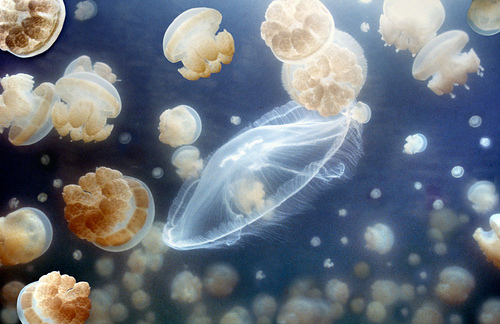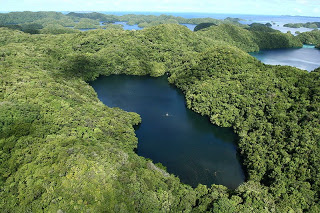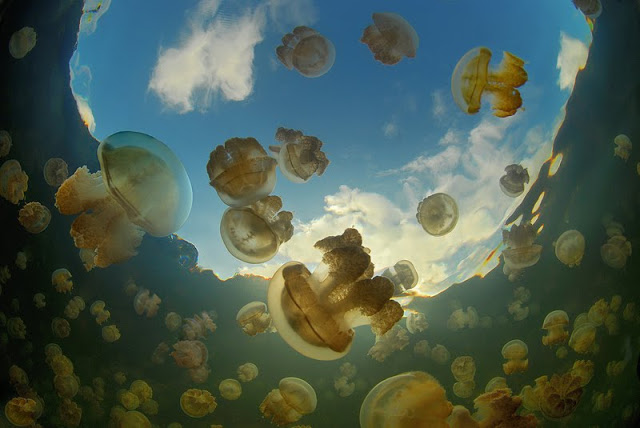Travel
The Republic of Palau (also spelled Belau or Pelew) is one of world's most spectacular diving and snorkelling destinations. Though most tourists who come here like to spend their time underwater exploring coral reefs, blue holes and hidden caves and tunnels, there's lots of Micronesian flora and fauna to be enjoyed too, from the exotic birds and fruit bats the size of hawks to the orchids that sprout in the backyards. Due to it's proximity to the Philippines, Manilla is one of four locations with direct flights in and out of Palau. These flights are relatively quick and inexpensive, making it easy to add at day or two of diving at the Palau islands to the trip. Other destinations with direct flights to and from Palau include Guam, Seoul, and Taipei.
If you were to snorkel just before dawn or dusk, you will witness a two-step jelly ballet, a simple rhythm as soothing and vital as a heartbeat. The jellies spend their days in privileged leisure, pulsating gently from one side of the lake to the other while rotating counterclockwise to catch the sun's rays and farming their own food supply of algae. While most of the jellyfish in the world sting, this is an unusual phenomena that allows you to actually go swimming safely with them.
- I Thought The Water Was Supposed To Rise In The Spring??
The water level here at the park continues to drop. Lake Diefenbaker is actually a reservoir lake, formed by a dam at the eastern end. Most of the water flow comes from the Rocky Mountains west of Calgary, and the spring runoff from the mountains really...
- Photo Of The Day: Lake Baikal
Ice Labyrinth, Lake Baikal, Siberia, Russia Lake Baikal is the oldest, the deepest and most voluminous freshwater lake on Earth. Its clear waters offer sanctuary to more than 1700 species of plants and animals, two thirds of which are endemic....
- 10 Best Scuba Diving Destinations
Scuba diving is more then just a sport. It's an adventure. The clear waters, the beautiful coral reefs teeming with life, the thrill of discovering a wreck or a cave, this are just some of the reasons people like scuba diving. The...
- Photo Of The Day: Tennessee Aquarium
This amazing jellyfish photo was taken by Flickr user cosmosjon at Tennessee Aquarium, one of the best aquariums in the USA. The Tennessee Aquarium is home to a richly diverse living collection of the world’s most fascinating animals, from colorful...
- Photo Of The Week: Yamdrok Yumtso Lake
Yamdrok Yumtso Lake. Photo by Flickr user zwz64 Yamdrok Yumtso Lake is one of the three largest holy lakes in Tibet. Surrounded by many snow-capped mountains and fed by numerous small streams, Yamdrok Yumtso Lake is believed to be the...
Travel
Jellyfish Lake. Where Darwin Has Never Been
The amazing Jellyfish Lake, teeming with millions of softly pulsating, stingless jellyfish, is to be found on one of Palau's islands, in South Pacific, about 800 km east of the Philippines. The lake features some outright miracles of evolution, like giant clams that weigh a quarter of a ton, and of course, the incredible jellyfish.
 |
| Jellyfish Lake, Republic of Palau by Olivier Blaise |
The Republic of Palau (also spelled Belau or Pelew) is one of world's most spectacular diving and snorkelling destinations. Though most tourists who come here like to spend their time underwater exploring coral reefs, blue holes and hidden caves and tunnels, there's lots of Micronesian flora and fauna to be enjoyed too, from the exotic birds and fruit bats the size of hawks to the orchids that sprout in the backyards. Due to it's proximity to the Philippines, Manilla is one of four locations with direct flights in and out of Palau. These flights are relatively quick and inexpensive, making it easy to add at day or two of diving at the Palau islands to the trip. Other destinations with direct flights to and from Palau include Guam, Seoul, and Taipei.
The Jellyfish Lake is one of Palau's most famous snorkelling sites. Situated on Eil Malk Island, approximately 45 minute boat ride from Koror, the lake is accessed by a short trail from the beach. The Jellyfish Lake is of marine origins and got famous for the hordes of golden jellyfish that migrate across it everyday. The turquoise-blue waters of the lake are home to some millions stingless jellyfish, some the size of melons, others the size of oranges and a few no bigger than cranberries.
 |
| Jellyfish Lake, aerial view by Anaxibia |
Jellyfish Lake is some 12,000 years old, a remnant of the last ice age. As the sea level rose, the water began to fill the Jellyfish Lake basin. When the glaciers receded, the jellyfish remained imprisoned in this tiny sea. This isolation allowed the species in the lake to develop on their own and become a unique species. If only Darwin would have known! Though the golden jellyfish haven't completely lost their stingers, they became so week that they cannot penetrate the human skin, although stings around the mouth and other sensible areas can be felt.
In spite the fact that the lake remains connected to the ocean through fissures and tunnels in the islands' porous limestone, this pocket of seawater is sufficiently isolated for the jellies to be substantially different from their close relatives living in the nearby lagoons. The lake is surrounded by high ridges covered in exuberant foliage and the sounds of the sea are muted by the music of the jungle: buzzing insects, chattering fairy terns, the singing of the Micronesian pigeon.
Tourists need a pass to access the Jellyfish Lake. The Rock Islands/Jellyfish Lake pass is $35 and is good for 10 days. Scuba diving in the lake is not allowed, part because the bubbles from scuba tanks can harm the jellyfish if they collect beneath their bell and part because the anoxic layer that begins at about 15 meters contains high concentrations of hydrogen sulphide which can be absorbed through the skin of a diver and can be fatal.
 |
| Jellyfish Lake by Lukas |
On the morning of December 27, 1831, H.M.S. Beagle, with a young Charles Darwin aboard, sailed out of Plymouth harbour under a calm easterly wind and drizzly rain. Nobody new by then the end result of this voyage, but it seems that a divine force out there wanted to bring fame to the finches of Galapagos instead of the jellyfishes of Palau. Beagle never made it anywhere close to the Jellyfish Lake's island.
Photos via Flickr Creative Commons
Photos via Flickr Creative Commons
- I Thought The Water Was Supposed To Rise In The Spring??
The water level here at the park continues to drop. Lake Diefenbaker is actually a reservoir lake, formed by a dam at the eastern end. Most of the water flow comes from the Rocky Mountains west of Calgary, and the spring runoff from the mountains really...
- Photo Of The Day: Lake Baikal
Ice Labyrinth, Lake Baikal, Siberia, Russia Lake Baikal is the oldest, the deepest and most voluminous freshwater lake on Earth. Its clear waters offer sanctuary to more than 1700 species of plants and animals, two thirds of which are endemic....
- 10 Best Scuba Diving Destinations
Scuba diving is more then just a sport. It's an adventure. The clear waters, the beautiful coral reefs teeming with life, the thrill of discovering a wreck or a cave, this are just some of the reasons people like scuba diving. The...
- Photo Of The Day: Tennessee Aquarium
This amazing jellyfish photo was taken by Flickr user cosmosjon at Tennessee Aquarium, one of the best aquariums in the USA. The Tennessee Aquarium is home to a richly diverse living collection of the world’s most fascinating animals, from colorful...
- Photo Of The Week: Yamdrok Yumtso Lake
Yamdrok Yumtso Lake. Photo by Flickr user zwz64 Yamdrok Yumtso Lake is one of the three largest holy lakes in Tibet. Surrounded by many snow-capped mountains and fed by numerous small streams, Yamdrok Yumtso Lake is believed to be the...
